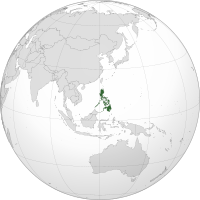Resident Commissioner of the Philippines
| Resident Commissioner of the Philippine Islands | |
|---|---|
Resident Commissioner of the Philippines | |
| United States House of Representatives | |
| Seat | Philippines |
| Formation | November 22, 1907 |
| First holder | Benito Legarda Pablo Ocampo |
| Final holder | Carlos P. Romulo |
| Abolished | July 4, 1946 |
The resident commissioners of the Philippine Islands (
Like current non-voting members, resident commissioners could speak and otherwise participate in the business of the House, but did not have full voting rights. Two resident commissioners were sent until 1937, when after the establishment of the Commonwealth of the Philippines, the number was changed to one.[1]
History
The Philippines was a United States territory from 13 August 1898 until Philippine independence was internationally recognized on 4 July 1946.
The office was first created by the
Election
The procedures for appointment of the resident commissioners were ambiguous and a source of friction.[2] Under the Philippine Organic Act of 1902, the two resident commissioners were to be elected by the Philippine Legislature, with each chamber (the entirely-appointed, American-majority Philippine Commission and the fully-elected and all-Filipino Philippine Assembly) voting separately. The resident commissioners were to be elected biennially from the time of the first meeting of the Philippine Legislature in 1907. Benito Legarda and Pablo Ocampo became the first two resident commissioners.
Upon the passage of the Jones Law in 1916, the resident commissioners were still selected in the same way, but by this time now had three-year terms. Jaime C. de Veyra and Teodoro R. Yangco were the first resident commissioners under the Jones Law.
The
The two resident commissioners serving under the Jones Law,
The resident commissioner was never elected via
List of resident commissioners
Insular government era: 1907–1936
| Seat A | Years | U.S. Congress | Philippine Legislature | Seat B | ||||
|---|---|---|---|---|---|---|---|---|
| Resident commissioner | Party | Electoral history | Resident commissioner | Party | Electoral history | |||
Manila )
|
Federalista )
(Republican |
Elected in 1907. Re-elected in 1909. Retired in 1912. |
November 22, 1907 – March 3, 1909 | 60th | 1st | Manila )
|
Democratic | Elected in 1907. Retired in 1909 to run in the Philippine Assembly. |
| March 4, 1909 – November 22, 1909 | 61st | |||||||
| 2nd | ||||||||
| November 23, 1909 – March 3, 1912 | 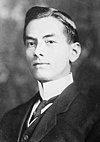 Manuel L. Quezon (Tayabas) |
Nacionalista | Elected in 1909. Re-elected in 1912. Retired in 1916 to run in the Philippine Senate. | |||||
| 62nd | ||||||||
| March 4, 1912 – March 3, 1913 | ||||||||
| Vacant | 3rd | |||||||
Manila )
|
Nonpartisan
|
Elected in 1913. Retired in 1916. |
March 4, 1913 – March 3, 1915 | 63rd | ||||
| March 4, 1915 – October 15, 1916 | 64th | |||||||
Manila )
|
Nacionalista | Elected in 1917. Re-elected in 1920. Retired in 1923. |
4th | |||||
| October 16, 1916 – March 3, 1917 | Vacant | |||||||
| March 4, 1917 – March 3, 1919 | 65th | 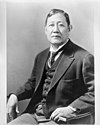 Teodoro R. Yangco (Zambales) |
Nonpartisan
|
Elected in 1917. Retired in 1920. | ||||
| March 4, 1919 – March 3, 1920 | 66th | |||||||
| 5th | Nueva Ecija )
|
Nacionalista | Elected in 1920. Re-elected in 1923. Re-elected in 1926. Resigned in 1928 to run in the Philippine House of Representatives. | |||||
| March 4, 1920 – March 3, 1921 | ||||||||
| March 4, 1921 – March 3, 1923 | 67th | |||||||
| 6th | ||||||||
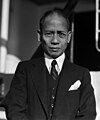 Pedro Guevara (Santa Cruz) |
Nacionalista | Elected in 1923. Re-elected in 1926. Re-elected in 1929. Re-elected in 1932. Retired in 1936 after change of form of government. |
March 4, 1923 – March 3, 1925 | 68th | ||||
| March 4, 1925 – March 3, 1927 | 69th | |||||||
| 7th | ||||||||
| March 4, 1927 – July 16, 1928 | 70th | |||||||
| July 16, 1928 – March 3, 1929 | 8th | Vacant | ||||||
| March 4, 1929 – March 3, 1931 | 71st | 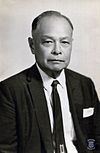 Camilo Osías (Balaoan) |
Nacionalista | Elected in 1929. Re-elected in 1932. Retired in 1934 to run in the Philippine Senate. | ||||
| March 4, 1931 – March 3, 1933 | 72nd | |||||||
| 9th | ||||||||
| March 4, 1933 – January 3, 1935 | 73rd | |||||||
| 10th | ||||||||
| January 3, 1935 – February 14, 1936 | 74th | Bulacan )
|
Nacionalista | Elected in 1934. Retired in 1936 after change of form of government. | ||||
Commonwealth era: 1936–1946
| Resident commissioner | Party | Years | U.S. Congress | Philippine president | Appointive history |
|---|---|---|---|---|---|
 Quintín Paredes (Bangued) |
Nacionalista | February 14, 1936 – September 29, 1938 | 74th 75th |
Manuel L. Quezon | Appointed in 1936. Resigned in 1938 to run in the Philippine National Assembly. |
Manila )
|
Nonpartisan
|
September 29, 1938 – August 9, 1944 | 76th 77th 78th |
Appointed in 1938. Resigned in 1944. | |
| Sergio Osmeña | |||||
Manila )
|
Nacionalista (1944–1946) . |
August 10, 1944 – July 4, 1946 | 78th 79th |
Appointed in 1944. Office eliminated when the United States recognized the independence of the Republic of the Philippines in 1946. | |
| Liberal (1946) |
Philippines's at-large congressional district
The resident commissioner represented the Philippines in the United States Congress.
See also
- List of Asian Americans in the United States Congress
- List of Hispanic and Latino Americans in the United States Congress
- Resident Commissioner
- Representatives of the United States to the Philippines:
- Governor-General of the Philippines from 1900 to 1935
- High Commissioner to the Philippines from 1935 to 1946
- List of ambassadors of the United States to the Philippines from 1946 to the present
- List of ambassadors of the Philippines to the United States, representative of the Philippines to the United States
References
- ISBN 0-520-23095-7.
- ISBN 9780807856536.
External links
- "PI Resident Commissioner - History". www.ourcampaigns.com. Retrieved August 28, 2020.

